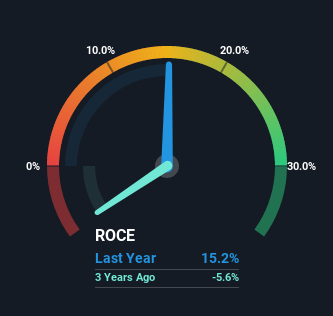- United States
- /
- Consumer Durables
- /
- NasdaqGM:LOVE
Investors Will Want Lovesac's (NASDAQ:LOVE) Growth In ROCE To Persist

What trends should we look for it we want to identify stocks that can multiply in value over the long term? In a perfect world, we'd like to see a company investing more capital into its business and ideally the returns earned from that capital are also increasing. If you see this, it typically means it's a company with a great business model and plenty of profitable reinvestment opportunities. Speaking of which, we noticed some great changes in Lovesac's (NASDAQ:LOVE) returns on capital, so let's have a look.
Return On Capital Employed (ROCE): What is it?
If you haven't worked with ROCE before, it measures the 'return' (pre-tax profit) a company generates from capital employed in its business. Analysts use this formula to calculate it for Lovesac:
Return on Capital Employed = Earnings Before Interest and Tax (EBIT) ÷ (Total Assets - Current Liabilities)
0.15 = US$38m ÷ (US$372m - US$119m) (Based on the trailing twelve months to January 2022).
Thus, Lovesac has an ROCE of 15%. That's a relatively normal return on capital, and it's around the 16% generated by the Consumer Durables industry.
View our latest analysis for Lovesac

In the above chart we have measured Lovesac's prior ROCE against its prior performance, but the future is arguably more important. If you'd like, you can check out the forecasts from the analysts covering Lovesac here for free.
What Does the ROCE Trend For Lovesac Tell Us?
We're delighted to see that Lovesac is reaping rewards from its investments and is now generating some pre-tax profits. The company was generating losses five years ago, but now it's earning 15% which is a sight for sore eyes. And unsurprisingly, like most companies trying to break into the black, Lovesac is utilizing 2,220% more capital than it was five years ago. This can tell us that the company has plenty of reinvestment opportunities that are able to generate higher returns.
In another part of our analysis, we noticed that the company's ratio of current liabilities to total assets decreased to 32%, which broadly means the business is relying less on its suppliers or short-term creditors to fund its operations. This tells us that Lovesac has grown its returns without a reliance on increasing their current liabilities, which we're very happy with.
The Bottom Line On Lovesac's ROCE
Long story short, we're delighted to see that Lovesac's reinvestment activities have paid off and the company is now profitable. Since the total return from the stock has been almost flat over the last three years, there might be an opportunity here if the valuation looks good. So researching this company further and determining whether or not these trends will continue seems justified.
One more thing: We've identified 3 warning signs with Lovesac (at least 1 which is a bit unpleasant) , and understanding them would certainly be useful.
If you want to search for solid companies with great earnings, check out this free list of companies with good balance sheets and impressive returns on equity.
New: AI Stock Screener & Alerts
Our new AI Stock Screener scans the market every day to uncover opportunities.
• Dividend Powerhouses (3%+ Yield)
• Undervalued Small Caps with Insider Buying
• High growth Tech and AI Companies
Or build your own from over 50 metrics.
Have feedback on this article? Concerned about the content? Get in touch with us directly. Alternatively, email editorial-team (at) simplywallst.com.
This article by Simply Wall St is general in nature. We provide commentary based on historical data and analyst forecasts only using an unbiased methodology and our articles are not intended to be financial advice. It does not constitute a recommendation to buy or sell any stock, and does not take account of your objectives, or your financial situation. We aim to bring you long-term focused analysis driven by fundamental data. Note that our analysis may not factor in the latest price-sensitive company announcements or qualitative material. Simply Wall St has no position in any stocks mentioned.
About NasdaqGM:LOVE
Flawless balance sheet with reasonable growth potential.


